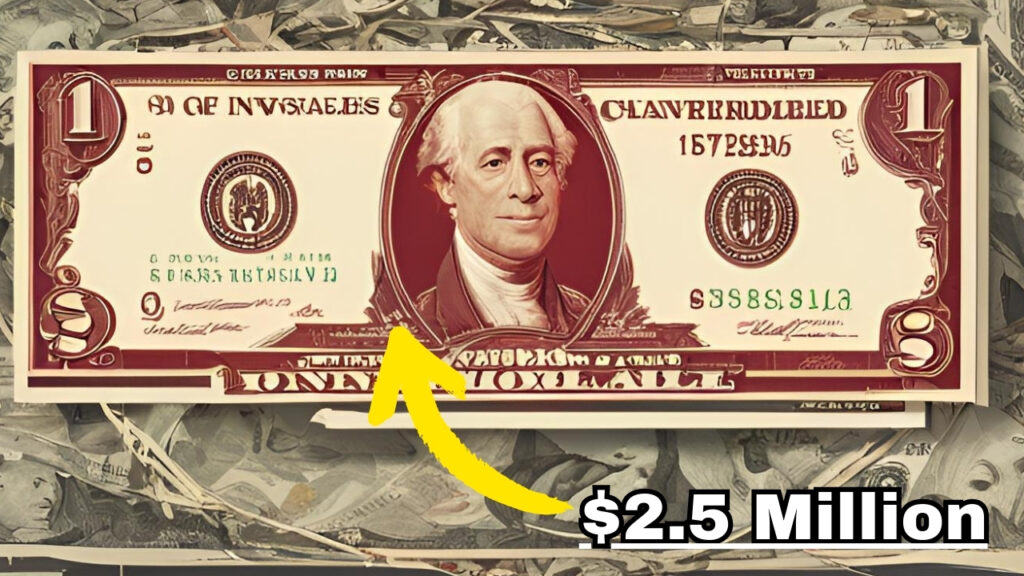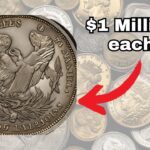Rare $1 Bill: In the intriguing realm of numismatics, there are few items as exciting as the rarest currency from the United States.
While many of us routinely carry crisp $1 bills without a second thought, there exists a fascinating world of paper money that is so scarce and sought after it can fetch prices in the millions.
Today, we’re diving deep into the captivating universe of rare $1 bills, particularly those that hover near the unbelievable market value of $2.5 million.
These remarkable pieces of American history continue to enchant collectors and enthusiasts globally, pushing prices to astonishing heights in the competitive world of numismatics.
First things first—let’s clear up a common misconception. There isn’t a single $1 bill that has officially reached the $2.5 million mark in the collector’s market.
Nonetheless, there are several incredibly rare notes that have come perilously close, and together, the rarest $1 bills could easily exceed this figure.
These exceptional notes symbolize not just financial value, but also important historical moments in the evolution of American currency, transforming them into invaluable artifacts of our financial heritage.
Rare $1 Bill: The Grand Watermelon Note – A True Numismatic Treasure
While technically not a $1 bill, the rarest American currency is undoubtedly the 1890 Grand Watermelon Note.
This $1,000 bill got its whimsical nickname from the distinctive shape of the zeros on its reverse side, which look like watermelons when viewed from afar.
In 2018, one of these remarkable notes was sold for a jaw-dropping $2.04 million at auction, setting a record for paper money.
The exquisite preservation and rich historical significance of this note contributed to its astronomical value, making it a gold standard in high-end currency collecting.
Rare $1 Bills That Command Top Dollar
While no $1 bills have hit the heights of the Grand Watermelon Note, several have garnered impressive values, each with a unique backstory:
1. 1869 $1 “Rainbow” Legal Tender Note
This colorful note features a portrait of Christopher Columbus and can fetch over $100,000 in top condition.
The printing techniques used back then were revolutionary, incorporating multiple colors to ward off counterfeiters.
The nickname “Rainbow” stems from the beautiful blend of red, blue, and green inks that were utilized.
2. 1890 $1 Treasury Note (Ornate Back)
With a portrait of Edwin Stanton, these ornate notes are highly sought-after, selling for upwards of $20,000 when uncirculated.
The intricate details and elaborate scrollwork on these notes showcase 19th-century printing at its finest.
Their ornate backs are seen as some of the most stunning ever crafted for American currency.
3. 1896 $1 Silver Certificate “Educational Series”
Part of the renowned “Educational Series,” this note features an allegorical scene representing History instructing Youth. In pristine condition, these notes can surpass $10,000.
These artistically significant notes symbolize a unique period in currency design, favoring allegorical figures and intricate symbolic scenes over traditional portraits.
The detailed artwork and historical significance appeal to collectors and art lovers alike.
4. 1899 $1 Silver Certificate “Black Eagle”
Showcasing a majestic spread-winged eagle, these notes are a favorite among collectors. High-grade examples can exceed $5,000.
The bold and patriotic design makes the Black Eagle note instantly recognizable and highly coveted.
The striking central vignette of the eagle has become iconic in the currency collecting arena.
Factors Affecting the Value of Rare $1 Bills
Several key elements drive the staggering values of these rare $1 bills, each playing a crucial role in their market worth:
1. Rarity
The scarcity of these notes, often due to limited printing runs or significant attrition rates, heavily influences their value.
Many of these rare notes are among the few remaining examples, making them especially treasured by collectors and institutions.
Rarity is perhaps the most vital factor in determining a note’s worth, as notes with lower print runs or higher destruction rates naturally hold more value.
This scarcity can be shaped by numerous factors, including initial production numbers and survival through various economic phases.
For instance, some notes became extremely rare due to government recalls, while others faded into obscurity due to wear and tear over time.
The link between scarcity and value is particularly visible when only a handful of specimens are known to exist, elevating prices to extraordinary levels among dedicated collectors and institutions.
2. Condition
The physical state of a bill can dramatically affect its worth. Uncirculated notes in pristine condition carry the highest premiums.
Collectors and grading services use detailed scales to assess the condition of notes, considering paper quality, color longevity, crispness, and the presence or absence of folds, tears, or stains.
Notes that remain uncirculated and retain their original printing characteristics are considered particularly valuable.
Even slight imperfections can significantly impact value, making condition assessment an essential skill in currency collecting.
Standardized evaluations from professional grading services help establish fair market values, aiding both buyers and sellers.
3. Historical Significance
Notes linked to important historical periods or events often carry additional value.
These bills serve as tangible reminders of significant moments in American history, from economic crises to advances in printing technologies.
Currency associated with major historical events tends to command higher prices.
The context surrounding a note enhances its allure for both collectors and historians, especially if the note represents a pivotal moment in monetary policy or design development.
Each bill’s story often adds unique intrigue and value beyond its physical attributes.
4. Unique Features
Errors in printing, unusual serial numbers, or distinct designs can greatly enhance a bill’s collectible value.
Error notes, resulting from printing mishaps, often become highly desirable among specialists.
Serial numbers with unique patterns, like repeating digits or special sequences, can also command substantial premiums.
Notes featuring experimental printing techniques or innovative security features usually attract keen interest from collectors.
These distinctive traits make each note special, transforming an otherwise ordinary bill into a valuable collectible.
The Hunt for Rare Currency
If you’re eager to explore this world of valuable notes, here are a few pointers:
-
Educate Yourself: Familiarize yourself with different types of currency and their identifying characteristics. This includes studying reference materials, joining numismatic organizations, and networking with experienced collectors. Knowing the subtle differences between genuine and counterfeit notes is vital, as is understanding printing techniques and historical context.
-
Check Your Wallet: While finding a valuable note in circulation is unlikely, it’s not impossible. Regularly inspect currency that passes through your hands; you could stumble upon an unattended treasure. Be on the lookout for older notes, unusual serial numbers, and distinctive features that may suggest special value.
-
Attend Currency Shows: These events can be fantastic for observing rare notes and meeting seasoned collectors. Currency shows offer the chance to examine authentic specimens, engage with other collectors, and learn from dealers and experts, along with opportunities to purchase authenticated notes to enhance your collection.
-
Be Cautious of Counterfeits: With values on the rise, the temptation for forgery increases. Always verify authenticity. Working with reputable dealers, utilizing professional grading services, and honing your authentication skills are key safeguards against fraud.
The Future of Rare Currency Collecting
As we transition into an increasingly digital economy, the appeal of rare paper money may become even stronger.
The tangible link to history that these notes provide is likely to be more cherished in our virtual age.
This shift towards electronic transactions may, paradoxically, elevate the value of physical currency, particularly rare pieces that symbolize critical chapters in monetary history.
Collectors and investors are viewing rare currency as both a passionate pursuit and a potential store of value.
Rare $1 Bill Conclusion: More Than Just Money
Even if the idea of a $2.5 million dollar bill is more myth than reality, the realm of rare currency holds a world of excitement for both collectors and history enthusiasts.
These precious pieces of paper are far more than mere money; they serve as gateways into our nation’s past, revealing narratives of economic shifts, artistic trends, and influential figures.
Each note unfolds its own unique story, preserved within the intricate designs and meticulous craftsmanship of its creation.
For many, the ordinary $1 bill remains just that—a basic method of transaction. However, for a fortunate few, these scarce notes epitomize the height of numismatic achievement, commanding prices that elevate simple currency into priceless treasures.
Safeguarding these historical artifacts guarantees that future generations can appreciate the artistry and progression of American currency.
Whether you’re a seasoned collector or simply intrigued by the potential hidden value in your wallet, the world of rare $1 bills provides an alluring glimpse into the intersection of history, art, and economics.
Who knows? The next time you handle a dollar bill, you might just be holding a piece of history worth far more than its face value.


